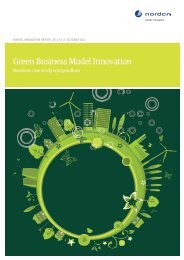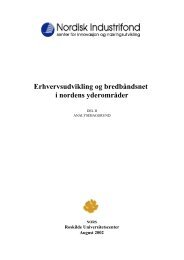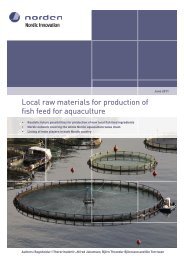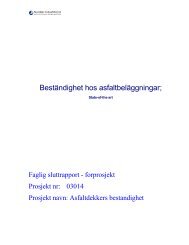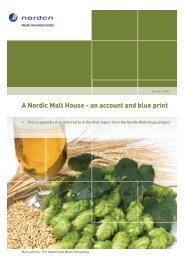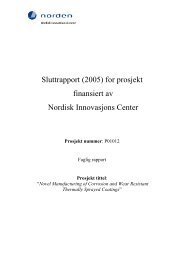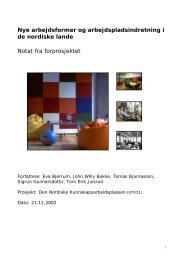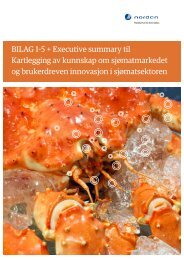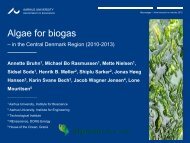Value added fish by-products - Nordic Innovation
Value added fish by-products - Nordic Innovation
Value added fish by-products - Nordic Innovation
You also want an ePaper? Increase the reach of your titles
YUMPU automatically turns print PDFs into web optimized ePapers that Google loves.
due to the strict EU regulations. There are developments towards a higher focus on the<br />
bioactive properties of the FPH and also an increased refinement of FPH in order to increase<br />
the bioactivity. In this project both different commercial FPH and laboratory prepared FPH<br />
have been evaluated as ingredients in lean and fatty food <strong>products</strong>.<br />
2.5 Fish gelatin<br />
Gelatin is derived from collagen, which is the principal constituent of connective tissues and<br />
bones. Covalent cross-linking organizes collagen molecules into a three-dimensional structure<br />
while each collagen triple helix is stabilized <strong>by</strong> hydrogen bonds between three left-handed<br />
helices called α-chains. Gelatin is mainly produced from collagen sources like bovine and<br />
porcine skins, and bovine bones. Although <strong>fish</strong> gelatin has been extracted from <strong>fish</strong> skins,<br />
which is a major rest raw material of the <strong>fish</strong> filleting industry, since 1960, only small<br />
commercial volumes are available (Veis 1964; Balian & Bowes 1977; Ledward 1986;<br />
Norland 1990; Schrieber & Gareis 2007).<br />
However, the outbreak of bovine spongiform encephalopathy (BSE) in Europe during the<br />
1990s has generated a greater focus on gelatin from cold and warm water <strong>fish</strong> as a possible<br />
alternative to mammalian gelatins. Gelatin has been extracted from several <strong>fish</strong> species<br />
including cod (Guðmundsson & Hafsteinsson 1997), hake (Montero et al. 1999), megrim<br />
(Montero & Gómez-Guilén 2000), black tilapia and red tilapia (Jamilah & Harvinder 2002),<br />
brown-stripe red snapper and big-eye snapper (Jongjareonrak et al. 2006), Alaska pollock<br />
(Zhou & Regenstein 2005), Atlantic salmon (Arnesen & Gildberg 2007), channel cat<strong>fish</strong><br />
(Yang et al. 2007), horse mackerel (Badii & Howell 2006) and Nile perch (Muyonga et al.<br />
2004).<br />
Although <strong>fish</strong> gelatin in contrast to bovine gelatin, is not associated with the risk of Bovine<br />
Spongiform Encephalopathy and contrary to porcine gelatin it is acceptable for Islam,<br />
Judaism and Hinduism, the commercial interest in cold water <strong>fish</strong> gelatin has been relatively<br />
low due to its suboptimal physical properties. Gelatin from cold water <strong>fish</strong> species exhibits<br />
lower gel strength, as well as lower gelling and melting temperatures compared to mammalian<br />
gelatin and gelatin from warm water <strong>fish</strong> species. This is due to a lower content of the imino<br />
acids, proline and hydroxyproline (Piez & Gross 1960; Norland 1990; Leuenberger 1991;<br />
Guðmundsson 2002; Haug et al. 2004).<br />
17



